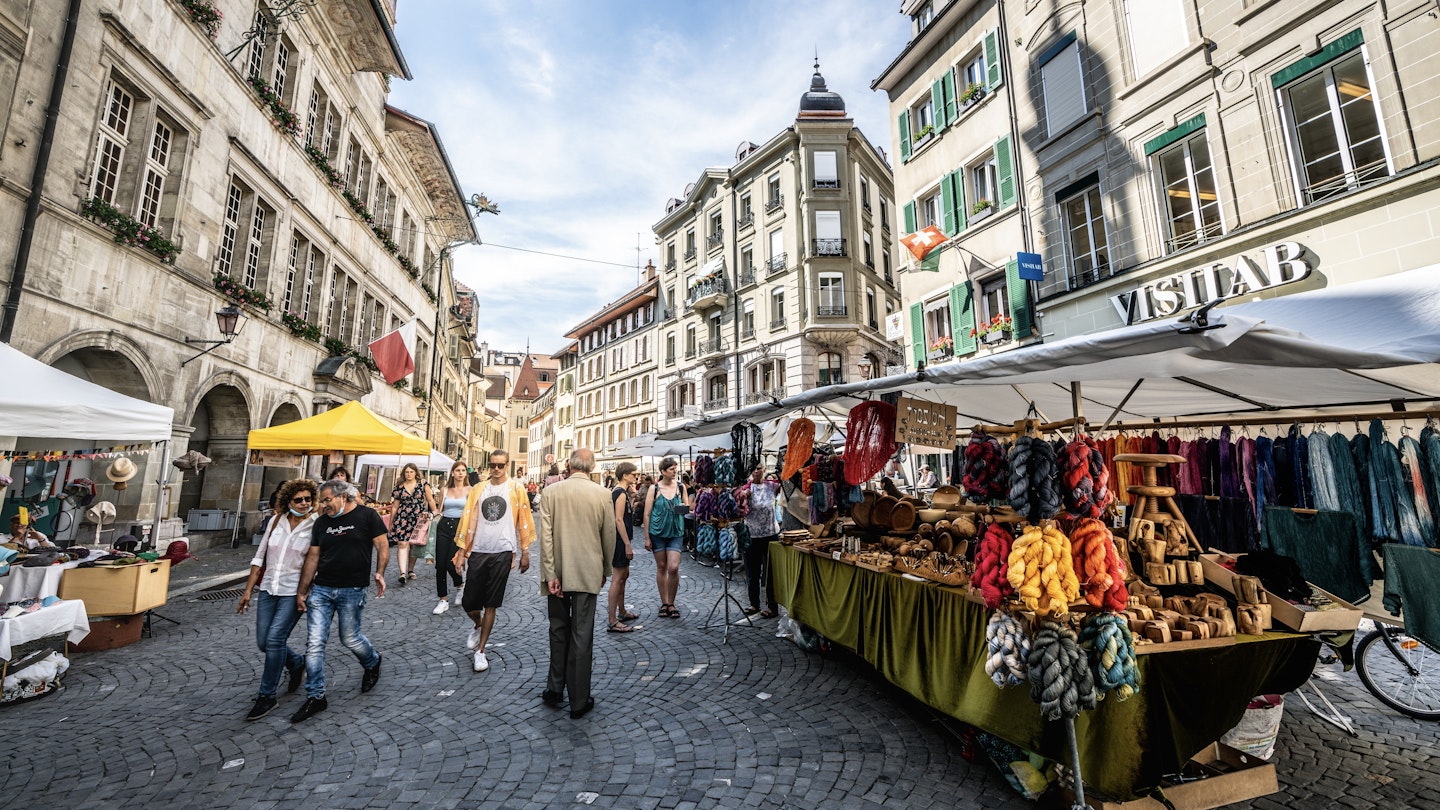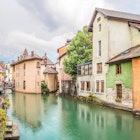

Get to know Lausanne with this roundup of the Swiss city’s top experiences. Shutterstock
Not far from its world-famous neighbor Geneva, the French-speaking Swiss city of Lausanne boasts a gorgeous lakeside location, youthful vibe and cultural riches.
While small, Lausanne all but bursts with options for visitors. From beaches and boat rides to vineyards and pop-up bars, these top things to do will make any trip here a real treat.
1. Browse sporting memorabilia dating back to 1896 at the Olympic Museum
Pierre de Coubertin, the founder of the modern Olympic Games, brought the International Olympic Committee to Lausanne in 1915. Today, the organization occupies a rather swanky lakeshore building at Vidy – and while tourists can’t go inside, they can go down the road to the Olympic Museum in Ouchy, an all-singing, all-dancing homage to the Games demonstrating the pride with which Lausanne celebrates its identity as the “Olympic Capital.”
Sports fans will love the permanent collection, which delves into the history of the Games and the values they aim to promote. You’ll see programs, medals, flags, torches, clothing and equipment dating back more than a century; watch videos of opening ceremonies and memorable moments; and explore the meaning of the Olympic spirit through interactive, audiovisual exhibits. The TOM Café is a good spot for a coffee with a view over the lake, while kids will love the park, with its running track and sculptures depicting Olympic sports.

2. Walk through Lausanne from top to bottom – then take the metro back up
The first thing you’ll notice about Lausanne is that it’s hilly. The Romans first established the village of Lousanna on the shore of Lake Geneva (le Léman, in French) – and the Cité, a fortified camp on a hill some 500m (1640ft) above the lake, became the town’s main population center in the Middle Ages. Contemporary Lausanne occupies both areas and the zones in between. And you can see it all by taking a leisurely downhill stroll.
Start in the Cité by exploring the 13th-century Gothic cathedral and the quiet cobbled streets that surround it. A sweeping view of Lausanne opens up the terrace outside the cathedral (which you can supercharge by climbing the 153 steps of the bell tower). From here, take the medieval wooden market steps down to the busy town center and Town Hall on Place de la Palud, before continuing your descent past the train station, through Grancy and beyond to the lakeshore at Ouchy. Reward yourself with an ice cream from Glaces Veneta before heading back up to town on the leg-saving M2 metro line.
Local tip: Pick up a sandwich, panini or sweet treat at Ässbar on Rue du Petit Chêne (you can snag yesterday’s bakery leftovers at a reduced price), and head to Parc de Milan for a picnic.
3. See art with a difference at the Collection de l’Art Brut
Art brut – literally “raw art” – refers to art made by self-taught artists, often on the fringes of society, who eschew artistic traditions or influences. The concept is associated with French artist Jean Dubuffet, who gifted his entire collection of such art to the city of Lausanne in the 1970s – on view today at the Collection de l’Art Brut. As well as the main collection, the museum regularly stages temporary exhibitions focusing on a single artist or theme. Come with an open mind – and prepare to see artworks born from a singular view of life.
Planning tip: The entry ticket is valid for three days and gives you admission to two other museums as well: the Musée Historique Lausanne near the cathedral and the Musée Roman de Lausanne-Vidy.

4. Go hiking and wine tasting in the Lavaux
If you didn’t know Switzerland was a wine-producing country, you’re in for a delightful surprise. The vineyards of the Lavaux, strung across the slopes above Lake Geneva between Lausanne and Montreux, date from the 12th century and are inscribed on UNESCO’s World Heritage List for their economic and cultural importance to the area.
Explore them on foot or bicycle by taking a regional train to your chosen starting point. The 11km (7-mile) stretch between the villages of Lutry and St-Saphorin makes a wonderful day hike. Undulating trails wind through the vines, with a fabulous view across the lake and to the French Alps beyond. En route, you’ll pass through pretty, pint-sized villages where wine cellars offer dégustations (tastings); you may even find a stall set up right in the vineyards. Try a Chasselas, the typical white wine of the area.
Planning tip: While the Lavaux is beautiful at any time of year, the vines look their finest in summer and fall. There’s little in the way of shade along the paths and the sun can be strong, so bring plenty of water, sunblock and a hat.
5. Shop local at the weekly market
Lausanne comes alive on Saturday mornings, when the market lands in town. You’ll find fruit and vegetables, cheese, flowers, spices, bread and pastries, fresh ginger juice and much more on the stalls lining the streets of the Vielle Ville (Old Town). While you’ll have a lovely morning even if you’re not buying anything, at least consider sampling a salée (a cheese tart) from the bakery stall in Place de la Riponne – there’s usually a line, so it’s easy to spot. A downsized market is also held on Wednesday mornings, while a flea market occupies Riponne on Thursdays.

6. Ogle fabulous views from Lausanne’s green spaces
Lausanne’s hillside topography makes for an abundance of gorgeous views, many of them from quiet, leafy spots where you can relax in the sun and contemplate life. Walk to the terrace above the botanical garden in Parc de Milan, take a picnic lunch to the pretty Esplanade de Montbenon or tackle the 302 steps of the viewing tower in Sauvabelin forest for the best panorama of the city, Lake Geneva and the mountains.
Detour: If you’re in Sauvabelin, it’s a short downhill walk to the Fondation de l’Hermitage, another of Lausanne’s art museums, which stages brilliant temporary exhibitions focusing on renowned Swiss or international artists.

7. Bar-hop on a Friday night (or any night, in fact)
With a big student population (it has a university, music school, art school, hospitality school and one of just two federal polytechnic schools), Lausanne thrives in the evenings most nights of the week. One hot spot is Place Benjamin-Constant, where a quartet of bar-restaurants creates a buzz that spills onto the pavements, particularly on a warm evening. Below the station, the Grancy district is a popular post-work hangout – try some Lavaux wines at Ta Cave or follow an apéro with dinner at the lively Café du Simplon or Café de Grancy. In summer, pop-up bars take over Lausanne’s quirky outdoor spaces, such as the Terrasse des Grands Roches under Bessières bridge (open seasonally) and La Grenette in Riponne. Lastly, the Great Escape pub (or “the Great,” as locals call it) has a huge, sun-soaked terrace that’s a big draw on sunny days.
8. Sample beach life in Lutry or Vidy
While it’s a landlocked country, Switzerland’s numerous lakes mean there’s no shortage of beach life here. On summer weekends, Lausanne’s city center empties out as everyone heads either to the mountains or the lake. The sandy beach in Vidy is hugely popular for sunbathing, swimming and barbecuing, and you’ll often see large family groups set up for the day with tables and chairs, grills, coolers and sound systems. The grassy lakeside at Lutry is a slightly calmer choice, and a good spot to hire a SUP and take to the water.
Detour: Lakeshore walks in either direction are just lovely. From Vidy, head toward Ouchy and you’ll pass several summer pop-up bars, including the hugely popular Jetée de la Compagnie. From Ouchy, continue toward Pully where there’s another pop-up bar, La Générale. It’s a pretty, 20-minute stroll from there to Lutry.

9. Discover Lausanne’s newest arts district, Plateforme 10
Lausanne punches above well its weight in terms of museums and cultural institutions, and Plateforme 10, open since 2019, is the latest evidence. A former train yard near the main station, it brings together three of the city’s museums that were previously spread throughout town: the MCBA (fine arts), MUDAC (contemporary design and applied arts) and Photo Elysée (photography). Each now has its own, airy, minimalist space in which to show off its collections, while the nearby railway arches house cafes and artisanal boutiques.
Planning tip: If you’re visiting in September, look out for the night of the museums, when most cultural attractions in the city are open into the small hours for one night only. Buy a pass for a small, one-off fee, and you’ll get access to every participating institution.

10. Savor the city’s cafe culture
It isn’t hard to find good coffee in Lausanne these days. Where once the city was dominated by traditional tea rooms, today it’s packed with youthful coffee bars, contemporary cafes and creative food trucks where coffee is treated as an art form. It’s a trend fueled in part by the presence in Lausanne of EHL, a world-leading hospitality school, whose graduates bring a steady stream of ideas and energy to the city’s food scene. For a great cappuccino or renversé (milky coffee), try popular cafe-bar Le Pointu, Italian-style cafe Non Solo or speciality coffee shop Ça Passe Crème.
Local tip: If hot chocolate is more your bag, head to Le Barbare, a Lausanne institution on the market steps below the cathedral, which serves thick, rich hot chocolate named after Marta, who used to run the place.

11. Ferry hop along the lakeshore from Ouchy – even over to France
It’s easy to get a train along the lake to visit other highlights of the so-called Swiss Riviera, such as Vevey, Montreux or Château de Chillon – but a much nicer way to travel is by boat. The CGN operates ferries from Lausanne’s port in Ouchy year-round, and the schedules and routes expand in summer, when it’s possible to ferry-hop to any of the small lakeside villages or go as far as Geneva, a six-hour ride. You can even sail across to France, with regular ferries to Évian-les-Bains and Thonon-les-Bains as well as the flower-strewn medieval French village of Yvoire.
Planning tip: You can buy tickets online in advance, or at the booth at Ouchy port on the day of travel. Transport passes such as the Swiss Travel Pass and Day Pass are also valid on the ferries.
Explore related stories







 Activities8 best things to do in France: the most unmissable experiences from Paris to Provence and beyond
Activities8 best things to do in France: the most unmissable experiences from Paris to Provence and beyondMay 23, 2024 • 7 min read



